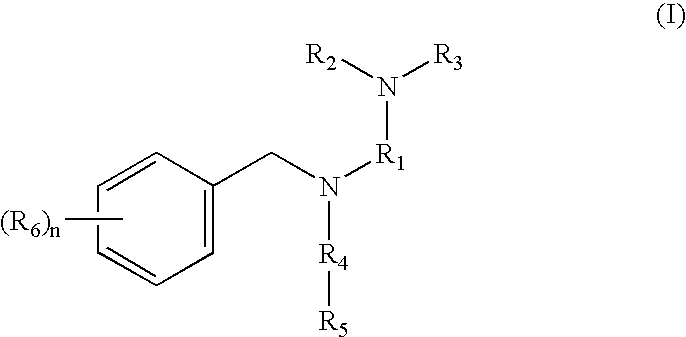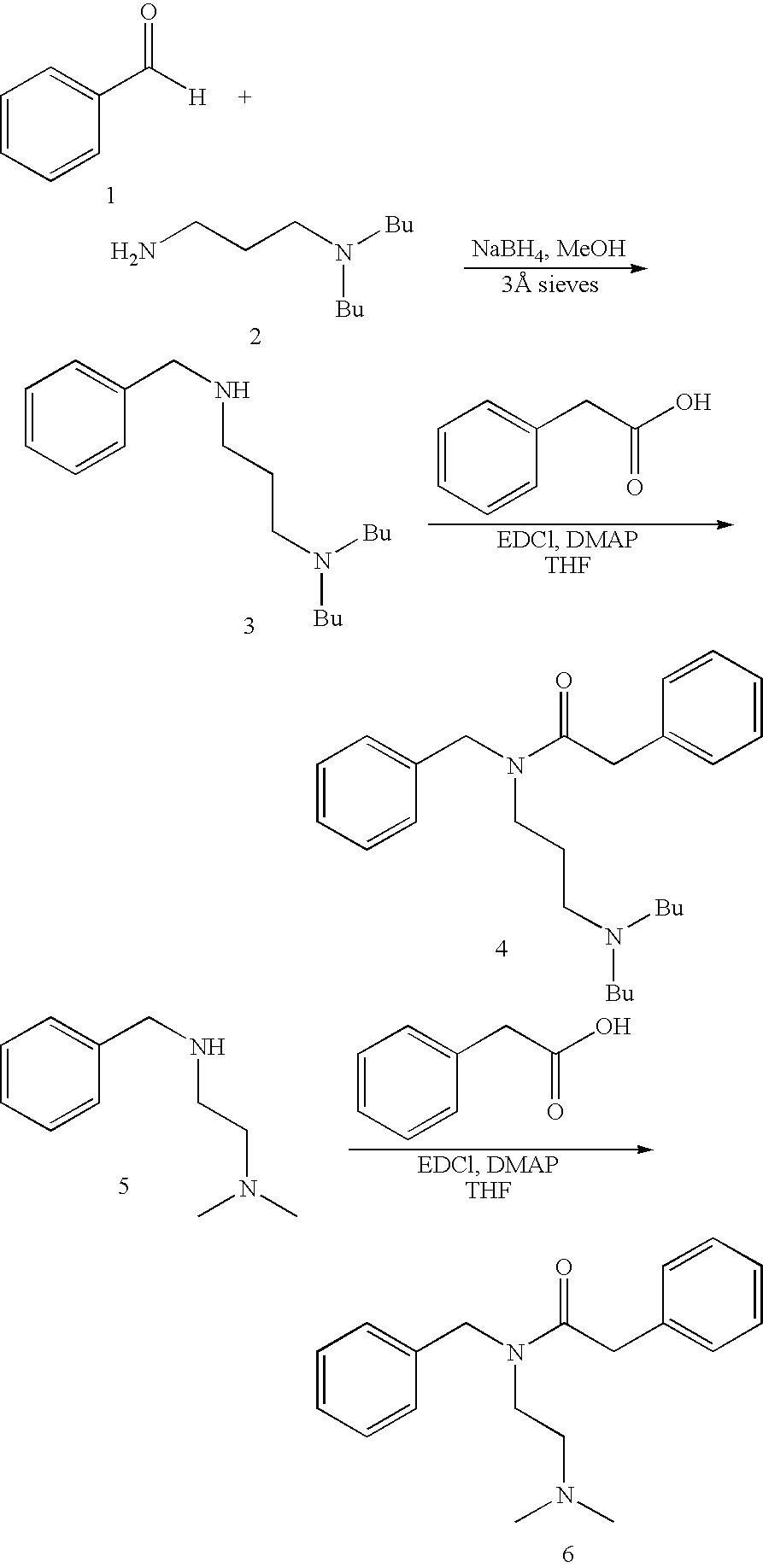Tertiary amino compounds having opioid receptor affinity
a technology of amino compounds and opioid receptors, applied in the direction of biocide, organic chemistry, drug compositions, etc., can solve the problems of unfavorable metabolism, respiratory depression, constipation, etc., and achieve the effect of sufficient time for metabolism
- Summary
- Abstract
- Description
- Claims
- Application Information
AI Technical Summary
Benefits of technology
Problems solved by technology
Method used
Image
Examples
examples 1 – 3
EXAMPLES 1–3
[0057]1-benzylamino-3-dibutylamino-propyl (Example 1);
[0058]1-[1-benzyl-1-(2-phenyl-1-oxo-ethyl)-amino]-2-dibutylamino-ethyl (Example 2); and
[0059]1-[1-benzyl-1-(2-phenyl-1-oxo-ethyl)-amino]-2-diethylamino-ethyl (Example 3).
[0060]The above compounds were synthesized according to the following synthetic scheme and general procedure:
Compound 3
example 1
[0061]To a solution of benzaldehyde (1, 3.1 g, 29.5 mmol) in anhydrous methanol was added 3-(dibutylamino)propylamine (2, 5 g, 26.8 mmol). After stirring 1 h in the presence of 3 Å molecular sieves, sodium borohydride (1.0 g, 26.8 mmol) was added. After stirring another 16 hours, the reaction was filtered, and the sieves were washed with dichloromethane. Water was added, and the phases were separated. The aqueous phase was made basic by addition of 15% aqueous NaOH, and it was then extracted with dichloromethane. The combined organic extracts were washed with water, washed with brine, dried with sodium sulfate, and concentrated. Silica gel chromatography eluting with 20:2:1 hexane-ethyl acetate-triethylamine provided compound 3 as a colorless oil: 1H NMR data (300 MHz, CDCl3): δ 0.88 (t, 6H, J=7.0 Hz), 1.26 (m, 4H), 1.37 (m, 4H), 1.64 (m, 2H), 2.35 (t, 4H, J=8.0 Hz), 2.43 (t, 2H, J=7.0 Hz), 2.64 (t, 2H, J=6.8 Hz), 3.75 (s, 2H), 7.15–7.40 (m, 5H).
Compound 4
example 2
[0062]To a solution of compound 3 (500 mg, 1.81 mmol) in anhydrous THF was added phenylacetic acid (246 mg, 1.81 mmol), EDCI (520 mg, 2.71 mmol), and DMAP (442 mg, 3.62 mmol), and the reaction mixture was allowed to stir 15 h. Water and dichloromethane were added, and the layers were separated. The aqueous phase was extracted with dichloromethane. The combined organic extracts were washed with 5% HCl, washed with saturated aqueous sodium bicarbonate, washed with water, washed with brine, dried with sodium sulfate, and concentrated. Silica gel chromatography eluting with 20:2:1 hexane-ethyl acetate-triethylamine provided compound 4 as a colorless oil: 1H NMR data (300 MHz, CDCl3): (2 rotamers) δ 2.20 (m, 6H), 1.25–1.90 (m, 8H), 1.58 (m, 1.2H), 1.68 (m, 0.8H), 2.15 (m, 6H), 3.25 (t, 1.2H, J=7.4 Hz), 3.40 (t, 0.8H, J=6.9 Hz), 3.68 (s, 0.8H), 3.80 (s, 1.2H), 4.50 (s, 0.8H), 4.63 (s, 1.2H), 7.05–7.45 (m, 10H).
Compound 6
PUM
| Property | Measurement | Unit |
|---|---|---|
| concentrations | aaaaa | aaaaa |
| concentrations | aaaaa | aaaaa |
| pH | aaaaa | aaaaa |
Abstract
Description
Claims
Application Information
 Login to View More
Login to View More - R&D
- Intellectual Property
- Life Sciences
- Materials
- Tech Scout
- Unparalleled Data Quality
- Higher Quality Content
- 60% Fewer Hallucinations
Browse by: Latest US Patents, China's latest patents, Technical Efficacy Thesaurus, Application Domain, Technology Topic, Popular Technical Reports.
© 2025 PatSnap. All rights reserved.Legal|Privacy policy|Modern Slavery Act Transparency Statement|Sitemap|About US| Contact US: help@patsnap.com



